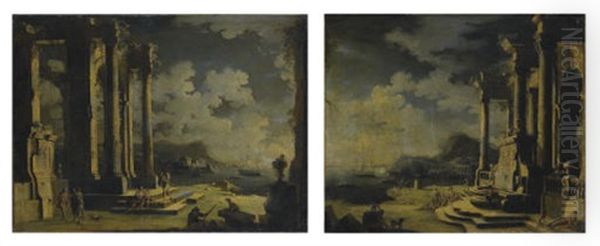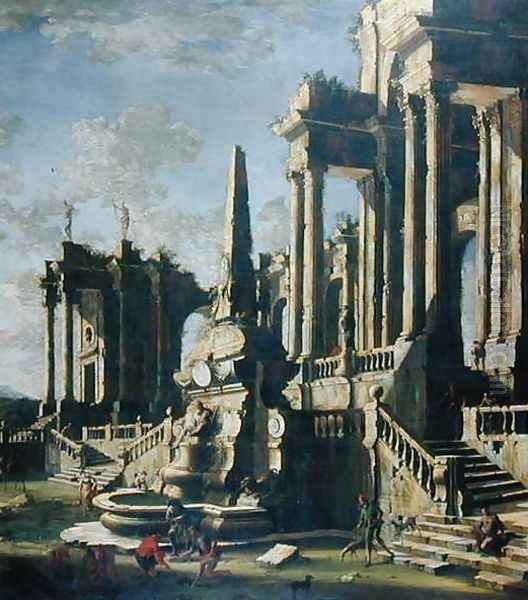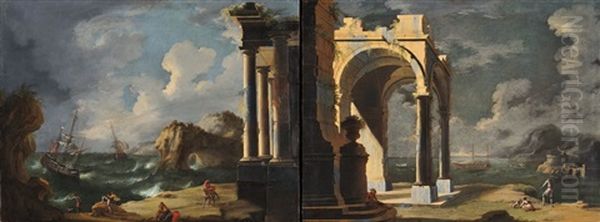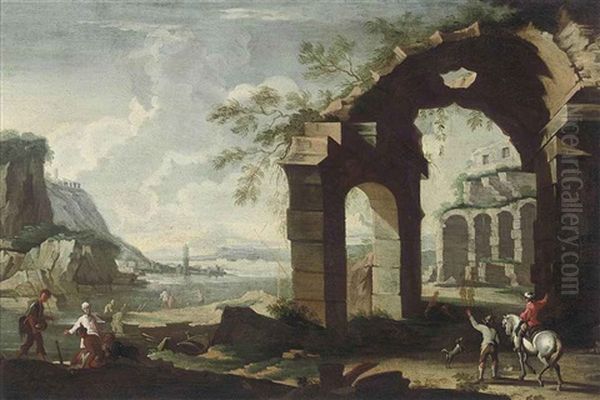Introduction: An Artist of Ruins and Imagination
Leonardo Coccorante stands as a significant figure in the landscape of 18th-century Italian art, particularly within the vibrant artistic milieu of Naples. Born in 1680 and active until his death in 1750, Coccorante carved a distinct niche for himself as a painter specializing in landscapes, known in Italian art history as vedute. However, his work often transcended mere topographical representation, venturing into the realm of the capriccio, or architectural fantasy. He is celebrated primarily for his evocative depictions of classical architectural ruins, often set against dramatic natural backdrops or bathed in ethereal moonlight.
Coccorante's artistic output is characterized by a fascinating blend of meticulous detail and soaring imagination. His canvases frequently feature grand, crumbling structures rendered with architectural precision, yet imbued with a sense of romantic melancholy and the passage of time. This unique fusion places his work at an interesting intersection of late Baroque, Rococo, Neoclassical, and burgeoning Romantic sensibilities. Active during a period of significant cultural and political change in Naples, Coccorante captured a particular fascination with antiquity, filtered through a lens of theatricality and atmospheric depth, securing his place as a key representative of Neapolitan landscape painting in his era.
Early Life and Unconventional Training
While detailed records of Leonardo Coccorante's earliest years are scarce, his birth in 1680 and death in 1750 place him firmly within the artistic developments of the late Baroque and Rococo periods in Italy. He spent the majority of his productive life in Naples, a bustling metropolis and a major European capital that served as a magnet for artists and patrons throughout the 17th and 18th centuries. His artistic formation involved tutelage under several established painters, indicating a path that began within the traditional workshop system.

Among his known masters were figures like Jan Frans van Bloemen, a Flemish painter active in Rome known for his classical landscapes, often earning him the nickname 'Orizzonte'. Coccorante also studied with Angelo Maria Costa, a Genoese painter whose work included landscapes and architectural scenes, potentially influencing Coccorante's thematic choices. Another named teacher is Gabriele Ricciardelli, a younger Neapolitan painter also known for vedute, suggesting Coccorante continued to engage with landscape specialists throughout his development.
However, a particularly intriguing, if perhaps apocryphal, anecdote surrounds his early training. It is recounted that Coccorante, at one point, served as an assistant jailer in a Neapolitan prison. During this time, he is said to have received instruction in painting techniques from a Sicilian inmate convicted of theft. While difficult to verify definitively, this story adds a layer of unconventionality to his artistic beginnings, suggesting a resourcefulness and a path perhaps less formally structured than that of contemporaries who might have trained exclusively under renowned masters like Francesco Solimena, the dominant figure in Neapolitan painting during Coccorante's prime.
The Artistic Climate of 18th-Century Naples
To fully appreciate Coccorante's contribution, it's essential to understand the artistic environment of Naples during his lifetime. The city, under Spanish and later Bourbon rule, was a major center of art, music, and culture. The arrival of Charles de Bourbon (later Charles III of Spain) as King of Naples and Sicily in 1734 ushered in a period of renewed artistic patronage and civic projects, including archaeological excavations at Herculaneum and Pompeii, which further fueled the European fascination with classical antiquity.
This environment fostered a demand for various types of painting. While large-scale history painting and religious commissions, often dominated by figures like Francesco Solimena and his followers such as Corrado Giaquinto (though Giaquinto worked largely outside Naples later), remained prestigious, there was also a thriving market for landscape painting, genre scenes, and decorative works. The legacy of earlier Neapolitan landscape traditions, notably the dramatic and untamed scenes of Salvator Rosa from the previous century, provided a backdrop against which artists like Coccorante developed their own interpretations of nature and architecture. Coccorante's focus on ruins resonated with the burgeoning Neoclassical interest in the classical past, yet his atmospheric and often imaginative treatment aligned with Rococo decorative tastes and prefigured later Romantic sensibilities.
Artistic Style: Between Veduta and Capriccio

Leonardo Coccorante is primarily classified as a vedutista, a painter of views. However, his work often leans heavily towards the capriccio, a genre that allowed for more imaginative and fantastical compositions. Unlike the topographically precise cityscapes of Venetian painters like Canaletto or Bernardo Bellotto, Coccorante's paintings frequently depict recognizable classical architectural elements – arches, columns, temples, statues – rearranged into idealized or entirely fictional settings. These are not necessarily faithful records of specific locations but rather evocative assemblages designed to stir the imagination and convey a mood.
His style is marked by a meticulous attention to architectural detail. Cornices, capitals, crumbling stonework, and sculptural fragments are often rendered with considerable precision, demonstrating a keen observational skill and understanding of classical forms. This detailed realism in the rendering of the ruins themselves provides a solid structural foundation for his compositions. Yet, this precision is often contrasted with a more painterly and atmospheric treatment of the surrounding landscape, sky, and sea. He excelled in creating dramatic effects of light and shadow, contributing significantly to the overall mood of his works. Giovanni Paolo Panini, working in Rome, explored similar themes of ruins and capricci, often with a brighter palette and a focus on contemporary Roman life amidst the ancient stones, offering a point of comparison to Coccorante's often more dramatic or nocturnal Neapolitan interpretations.
Light, Atmosphere, and Pre-Romantic Sensibilities
A defining characteristic of Coccorante's art is his masterful use of light and atmosphere. He frequently depicted scenes under dramatic conditions – stormy skies, the ethereal glow of moonlight, or the sharp contrasts of light and shadow in nocturnal settings. This emphasis on atmospheric effects moves his work beyond simple architectural documentation towards a more emotional and evocative register. His moonlit ruins, populated by small, often indistinct figures, evoke feelings of mystery, melancholy, and the sublime power of nature reclaiming man-made structures.
These qualities align Coccorante with pre-Romantic sensibilities emerging across Europe in the 18th century. The fascination with ruins, the emphasis on mood over topographical accuracy, and the suggestion of narratives involving bandits or solitary figures contemplating the decay of empires all anticipate themes that would become central to the Romantic movement later in the century and into the 19th century. While perhaps not as wild or overtly tempestuous as the landscapes of his Neapolitan predecessor Salvator Rosa, Coccorante's work shares a similar interest in the dramatic and the picturesque. His approach can also be seen in dialogue with French contemporaries like Claude Joseph Vernet, known for his dramatic seascapes and landscapes, whom the provided sources mention as an influence, or Hubert Robert, who later became famous for his picturesque paintings of Roman ruins.
Compositional Strategies and the Use of Staffage

Coccorante typically employed compositions that emphasized the grandeur and scale of the architectural ruins. These structures often dominate the canvas, towering over the landscape and the small human figures included within the scene. This deliberate contrast in scale serves to highlight the monumentality of the past and the relative insignificance or transience of the present inhabitants. The ruins act as the main protagonists of the painting, their crumbling forms telling stories of time, decay, and former glory.
The small figures populating his scenes, known as staffage, are crucial compositional and narrative elements. They are rarely specific individuals but rather types – soldiers, fishermen, elegantly dressed ladies and gentlemen, peasants, or sometimes more mysterious figures like bandits. These figures serve multiple purposes: they provide a sense of scale, animate the scene, add touches of color and narrative interest, and guide the viewer's eye through the composition. This use of staffage was a common practice in landscape painting, employed by artists ranging from the idealized classical landscapes of Claude Lorrain and Nicolas Poussin to the vedute and capricci of Panini and Coccorante himself. The influence of Viviano Codazzi, noted in the source material for his integration of geometry, light, idealized landscapes, and figures, seems pertinent here.
Influences and Artistic Dialogue
Coccorante's style was shaped by a confluence of influences. The dramatic naturalism and imaginative spirit of Salvator Rosa undoubtedly left a mark on the Neapolitan artistic consciousness, likely informing Coccorante's atmospheric approach. His training under Jan Frans van Bloemen ('Orizzonte') would have grounded him in the tradition of classical landscape painting derived from artists like Gaspard Dughet and ultimately Claude Lorrain, emphasizing idealized nature and balanced compositions. His association with Angelo Maria Costa exposed him directly to the theme of ruins and architectural landscapes.
Furthermore, the source material highlights the influence of Viviano Codazzi, an earlier specialist in architectural perspectives (quadratura) and ruins, known for his geometric precision and dramatic lighting – elements clearly visible in Coccorante's work. Coccorante synthesized these influences, adding his own penchant for dramatic atmosphere and imaginative recombination. He operated within a Neapolitan school that included figure painters like Francesco Solimena and Paolo de Matteis, but he specialized in a genre that allowed him to carve his own path, focusing on the evocative power of landscape and architecture. His work can also be compared to that of Marco Ricci, a Venetian contemporary who also excelled in painting ruins and imaginative capricci.
Recurring Themes: Ruins, Ports, and Fantastical Scenes

The most dominant theme in Coccorante's oeuvre is the classical ruin. He painted crumbling temples, triumphal arches, colonnades, pyramids, and sculptural fragments, often combining elements from different sources or inventing them entirely. These ruins were not just architectural studies; they were symbols of the passage of time, the vanity of human ambition, and the enduring power of history and nature. They provided settings for contemplation, melancholy, or sometimes, more dramatic narratives.
Coastal scenes and ports also feature prominently in his work, as evidenced by titles like Port of Ostia in Calm Weather and Port of Ostia During a Tempest. These paintings often combine architectural elements, such as harbor structures or nearby ruins, with depictions of ships and maritime activity, sometimes under dramatic weather conditions like storms. This allowed him to explore the interplay of architecture, nature (specifically the sea), and human activity. Works titled Marina further attest to his interest in seascapes. The frequent depiction of nocturnal scenes, such as Nocturnal Ruin Scene or Sacrifice of Abraham (set amidst ruins at night), underscores his fascination with specific lighting conditions and the mysterious atmosphere they create.
A Painter at the Bourbon Court
Coccorante's talent did not go unnoticed by the ruling powers in Naples. He achieved the prestigious position of court painter, serving Charles de Bourbon. This appointment reflects the high regard in which his specialized skills were held. His role extended beyond easel painting; between 1737 and 1739, he was specifically engaged in the decoration of the Royal Palace in Naples. This type of commission often involved creating large-scale decorative landscapes or architectural scenes designed to adorn the palace interiors, integrating his artistic vision with the broader decorative schemes favored by the court.
Working for the court placed Coccorante within the orbit of official patronage and connected him with the major artistic projects of the time. It provided financial stability and enhanced his reputation, positioning him as one of the recognized specialists in his field within the kingdom. His contributions to the Royal Palace, though perhaps less documented than the grand figurative cycles by others, were part of the extensive efforts under Charles de Bourbon to embellish the royal residences and project an image of cultural sophistication and power.
Collaborative Ventures in the Workshop Era
The practice of artistic collaboration was common during the 17th and 18th centuries, particularly in large workshops or for complex commissions. The provided sources mention that Coccorante collaborated with other artists, specifically naming Giovanni Marzio, Tommaso Girolami, and Giacomo del Po. Giacomo del Po was a respected Neapolitan painter known for his decorative frescoes and easel paintings, suggesting collaborations might have involved Coccorante providing the landscape or architectural settings for figures painted by Del Po, or vice versa, depending on the specific commission.
Such collaborations allowed artists to leverage their respective specializations, leading to richer and more complex final works. For Coccorante, working with figure painters could enhance the narrative elements within his landscapes and ruins. These partnerships reflect the practical realities of artistic production in the period, where specialization and efficient workshop practices were often key to fulfilling diverse commissions, from easel paintings for private collectors to large-scale decorative projects for the church or state.
Exploring Key Works
Several specific works help illustrate Coccorante's style and thematic concerns:
Port of Ostia During a Tempest (c. 1740s, Lowe Art Museum): This painting exemplifies his ability to combine architectural elements (Roman ruins associated with the ancient port of Ostia) with dramatic natural phenomena. The stormy sea and sky create a dynamic and turbulent atmosphere, contrasting with the enduring, albeit crumbling, man-made structures. The small figures battling the elements would further enhance the sense of drama. A related title, Port of Ostia in Calm Weather, suggests he explored the same location under different atmospheric conditions.
Nocturnal Ruin Scene / Scène nocturne dans les ruines (Musée Départemental de l'Oise, Beauvais): This title points directly to one of his signature themes. Such works typically feature classical ruins illuminated by moonlight, casting long shadows and creating an atmosphere of mystery and quiet grandeur. The darkness would obscure details, allowing the focus to be on the silhouettes of the architecture and the evocative play of light.
Sacrifice of Abraham (c. 1730-1740, Musée Départemental de l'Oise, Beauvais): Setting this biblical scene within a landscape of ancient ruins at night is a characteristic choice for Coccorante. It blends religious narrative with his preferred architectural and atmospheric themes, using the dramatic backdrop to heighten the emotional intensity of the story.
Capriccio architettónico con figure (Architectural Capriccio with Figures): This generic title likely applies to many of his works. One example noted in the source, dated perhaps to the 1750s (though this date seems problematic if he died in 1750, possibly referring to a style period or inventory date), was considered among his best. These capricci showcase his imaginative recombination of architectural motifs and his skill in creating complex, visually engaging compositions populated by staffage.
Landscape with Roman Ruins and Figures (Auckland Art Gallery Toi o Tāmaki): Another title indicative of his core subject matter, likely featuring a collection of classical fragments set within an idealized landscape, animated by small figures that provide scale and context.
Imaginary Ruins (Temple Newsam House, Leeds): This title explicitly confirms the fantastical element in much of his work, emphasizing that his creations were often products of imagination rather than strict topographical records.
Legacy, Collections, and Historical Position
Leonardo Coccorante holds a secure place as one of the most distinctive landscape and capriccio painters of the 18th-century Neapolitan school. While perhaps overshadowed during his lifetime and immediately after by the dominant figure painters, subsequent art historical evaluation has recognized the quality and originality of his work. He successfully synthesized influences from Italian and Northern European landscape traditions, Neapolitan predecessors like Rosa, and contemporaries like Panini, creating a personal style characterized by atmospheric drama and meticulous architectural rendering.
His specialization in ruins catered to the growing antiquarian interests of the era and the taste for the picturesque, prefiguring the more intense Romantic engagement with the past. His influence extended to later Neapolitan painters, including Gennaro Greco, who continued the tradition of decorative landscape and ruin painting. Coccorante's work also found appreciation outside Italy, contributing to the broader European fascination with Italian landscapes and classical ruins, a taste particularly strong in Britain among Grand Tour travelers. The presence of his works in collections in the UK (Piraneseum, London; Temple Newsam, Leeds) and the USA (Lowe Art Museum, Florida; Orlando Museum of Art, Florida), as well as France (Musée de l'Oise, Beauvais) and New Zealand (Auckland Art Gallery), attests to this wider recognition. His dramatic compositions might even be seen as painterly counterparts to the powerful architectural etchings of Giovanni Battista Piranesi in Rome, who similarly explored the sublime grandeur of ancient ruins.
Conclusion: A Vision of Grandeur and Decay
Leonardo Coccorante navigated the artistic currents of 18th-century Naples to create a body of work that remains captivating for its unique blend of architectural precision and atmospheric imagination. As a master of the veduta and, more specifically, the capriccio, he transformed depictions of classical ruins into stages for evocative narratives and meditations on time, history, and the sublime power of decay. His dramatic use of light, particularly in nocturnal and moonlit scenes, imbued his landscapes with a pre-Romantic sensibility that resonated with the evolving tastes of his era.
Through his service to the Bourbon court and his prolific output of easel paintings, Coccorante made a significant contribution to the Neapolitan school, specializing in a genre that perfectly captured the contemporary fascination with antiquity while allowing for considerable artistic invention. Though perhaps not as widely known as some of his Italian contemporaries, his skillful compositions, atmospheric depth, and imaginative treatment of architectural ruins secure his position as an important and distinctive voice in 18th-century European art, a painter who masterfully conjured visions of grandeur haunted by the poetry of decay.